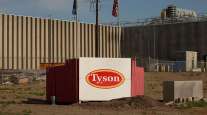Senior Reporter
Truck Drivers on the Lookout for Spotted Lanternfly

A troublesome tiny Asian visitor known as the spotted lanternfly is hopping from fruit trees onto trucks and railcars throughout the southeastern corner of Pennsylvania, threatening to ruin billions of dollars of agricultural commodities in the state and elsewhere.
It’s a hitchhiking bug that doesn’t bite, doesn’t sting, but can quickly destroy grapes, trees, nursery stock and apples, to name just a few of its victims. Agricultural experts believe the invasive insect came to the United States after hopping on a boat from China. It was first spotted in Pennsylvania’s Berks County in 2014.

The spotted lanternfly is causing trouble for trucking companies. (Melissa Chippie)
Since then, it has spread like wildfire, spotted in large numbers in 13 Pennsylvania counties now under quarantine, and has been seen in the southern part of New Jersey, Virginia and Delaware — and officials fear the pest could even make its way to vineyards in New York state.
“It’s not a strong flier. It’s a hitchhiker,” said Dana Rhodes, the Pennsylvania Department of Agriculture’s chief plant regulatory official.
The insect has particularly been a headache for trucking companies hauling an array of agricultural products ranging from grapes to hardwoods, according to Chris Salisbury, transportation manager at Rheems, Pa.-based Wenger Feeds, a company with 75 trucks that haul mostly animal feeds and hardwoods.
“My drivers will go onto a farm in, say, Berks County, and they will see the spotted lanternfly and will make sure that they report the infestation to the state,” Salisbury said. “And then they need to make sure none of those critters get onto the truck and leave with them. We’ve told our drivers to keep their windows rolled up and to look for any ride-alongs.”
Truck drivers doing business in affected areas are warned that if they park below a tree line, the vibrant-colored insect can hop onto their truck, hide in a tiny crevice or atop a flatbed and do extensive damage to a valuable load of agricultural commodities.
Help us protect Pennsylvania's grapes, hops, and hardwood. If you see a Spotted Lanternfly, report it https://t.co/ZmMZvFCYFN https://t.co/fVWDrwPe2W — Pennsylvania (@PennsylvaniaGov) August 1, 2017
The only way to stop the lanternfly is to use a pesticide, stomp on it with your boot or smash it with a fly swatter, Rhodes said.
“It threatens, we believe, $18 billion worth of Pennsylvania agriculture products,” said Shannon Powers, a spokeswoman for the state’s Department of Agriculture.

Spotted lanternflies are prevalent throughout southeastern Pennsylvania. (Cindy Kerstein)
As a result, the U.S. Department of Agriculture has awarded the state $17.5 million to help eradicate the pest, according to Powers.
She added, “It secretes a substance called honeydew that then makes the plants susceptible to mold. It destroys them, makes blenders grapes in particular unusable and inedible.
“It does feed on some trees and some woody vines. It doesn’t actually eat fruit. It basically ruins the fruit.”
Already, state police and agricultural inspectors are on watch, randomly pulling over trucks — not for speeding, but to inspect for lanternflies. Inspectors have been known to turn trucks around and, beginning in May, truckers could be fined for not carrying an inspector’s permit or not having been trained by their company managers to spot and rid their trucks of the tiny critter, Pennsylvania Motor Truck Association spokesman Brandon Moree said.
Although the lanternfly has been wreaking havoc with agricultural businesses for some time, the invasive insect remains a bit of a mystery, according to Heather Leach, an extension associate in Penn State University’s entomology department.
“We still don’t know a lot about this insect and how to manage it,” Leach said. “But because it has such a large host range, it’s been a nuisance problem for homeowners, businesses and certainly transport companies. It’s a strange insect in that it affects a lot of people, practically everyone who’s living down in southeast Pennsylvania. Which is fairly unique.”
SLF Permit Training by on Scribd
Leach said that the bug is mostly having an effect on the grape industry, the forestry industry and ornamental backyards. “Part of the problem is that it’s an indirect feeder. It’s a piercing, sucking plant pest, feeding on plant stock,” she said. “It’s not feeding directly on fruit, the apple or grape fruit itself; it’s feeding on the trunk, the vine or branches.”
The infestation can present an even greater challenge to independent owner-operators who carry loads from all over the United States to Pennsylvania who might not have any knowledge of the insect or the requirements to get an inspection permit, Salisbury said.
“So now we’re trying to educate the shippers, states and the federal government,” Salisbury said. “We’re not going to be able to make sure that only Pennsylvania trucks haul Pennsylvania goods. It’s just impossible.”




